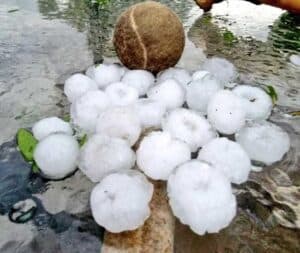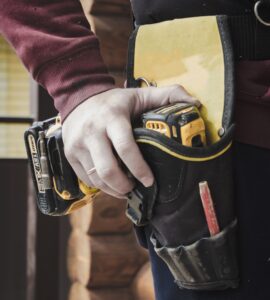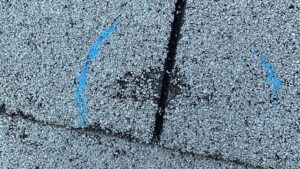Your roof looks a little green. Why is that discoloration happening, and what does it mean for the structure of your home? Often, that green material is moss, a type of growing plant material that can spread quickly over the structure. It may look pretty, even a bit charming, but it is not something that you want to allow to remain present (and you should know how to get rid of it properly).
What Is Moss Anyway?
A good starting point is understanding what’s growing on the roof. Most often, it’s called moss, but there are different types of potential material on the structure, including algae and lichens. Most importantly, it’s an organic material that thrives in these conditions. Moss itself is bryophyte, which comes from water-based plants. It’s usually spread across the surface like a mat or carpet and looks springy and soft. Most will grow if there is water on the roof.
You may have algae on your roof if it doesn’t seem to have any type of leaves, roots, or stems. Called thallophyte, it also grows in or near strong sources of water. Most often, it grows in clusters, spreading over a surface in an uneven pattern.
A third potential option is a lichen, which is a fungi and algae combination. It’s a fungus that grows alongside the allege and can look dark and blotchy (there are various types of it, and each one can be a bit different in terms of overall cause).
Why Is There Moss on Your Roof?
As an organic material, moss needs water to grow. If it has that and has a food source, like leaves in the gutters or twigs from fallen tree branches, it is likely to grow. Moss also loves to grow in shaded areas, which means that the areas of your roof that have overlapping tree branches tend to be one of the most likely places where moss will thrive. The shade over the roof creates a way to stop the evaporation of moisture from occurring readily, creating the ideal environment to foster moss growth.
You are most likely to find moss on your roof if:
- It is shaded (or has some areas of shade)
- There are a lot of leaves or other organic materials on the roof or nearby
- There’s moisture either from rain that doesn’t dry quickly or from within the home
Is Moss on a Roof a Bad Thing?
There’s no good reason for it to be there. Over time, it will create damage to the roofing structure, and it could mean roof repairs as well. That’s because moss is a living and growing plant, and as it invades the structure of your roof, it’s going to do damage along the way.
One way it does this is that it removes the protective oils that are on most asphalt shingles. This coating is what helps to minimize damage to the shingles from the sun’s rays or from rain-related erosion. That means that, over time, the moss encourages the surface to crack and warp. You may notice the shingles nearby are curling up around the edges, for example. When this happens, you’ll need to replace the shingles (or sometimes the whole roof).
The other problem is that most moss is very wet. It maintains a high level of moisture, and as it does that, it keeps the surface of the roof wet as well. The rain absorbs into the moss and stays there, encouraging not just a weakening of the structure but also feeding the growth of the moss, allowing it to grow quickly and spread over the top of the surface.
As moss continues to expand, it doesn’t just stay on the top of the surface but penetrates under the shingles. That allows for moisture to build up on the roofing structure and eventually leads to leaks. It is not uncommon for this to cause the wood to rot and for mold to develop as well. That becomes a health risk and could put the structure of your home at risk.
What Should You Do If There’s Moss on Your Roof?
You can try to clean the moss or other material from your roof, but this takes a lot of work, and it requires careful use of the right equipment. Too much pressure, from a power wash, for example, can damage the shingles. You can also use the wrong chemicals, which could damage the surface and put your home’s landscaping at risk.
If possible, turn to a professional to clean the surface of the roof instead. They will use specific methods to protect the roof itself and provide an exceptional level of attention to detail. Remember, moss sticks around and can handle most types of weather. Without properly cleaning and removing it all – and treating any underlying problems, it’s likely that it will come back.
How Can You Prevent Moss on Roofs?
Prevention is always the best option, and even in the most ideal situation, there could still be some development. These tips make it less likely for moss to grow on your roof:
- Keep the gutters and the surface of the roof clean. Removing organic debris, including leaves, twigs, and branches helps to minimize the food source for moss. Remove any buildup of material from the surface on a routine basis.
- Check the surface of the roof for holes, loose or missing shingles, or areas of weakness. These areas make it possible for moss to grow hidden for some time.
- Ensure you have your roof professionally cleaned when possible. Do this annually or every other year, depending on where you live. This will help to remove more of the grin and stains as well as minimize the potential for moss to grow.
- Ensure there’s no standing water on your roof or in your gutters. That could help encourage the growth of moss, algae, and mold on the surface of your roof.
- Trim back branches or other overhang that creates shaded areas to the roof. That way, the roof can dry quickly after rain.
Taking these steps, you’ll be better able to protect your roof from a wide range of problems that are typical.





